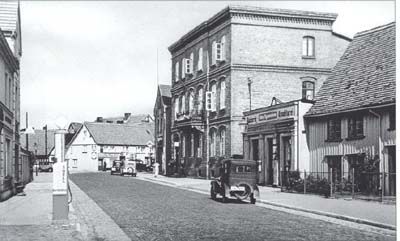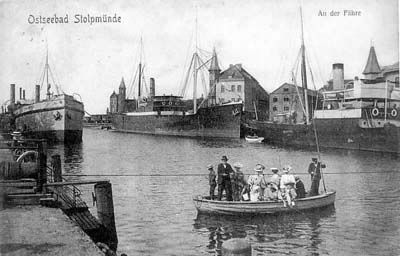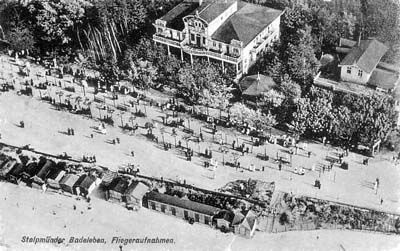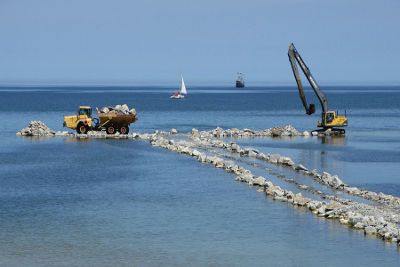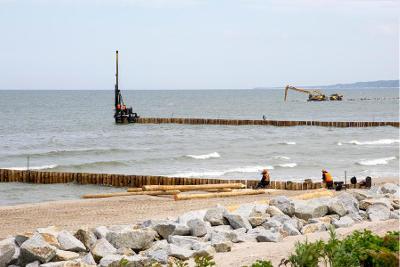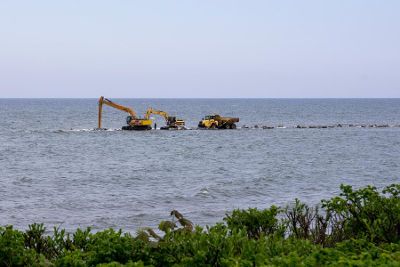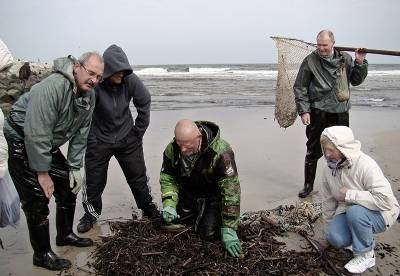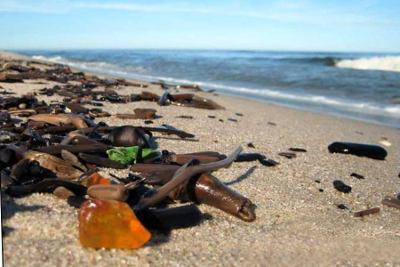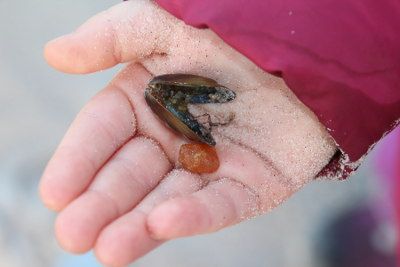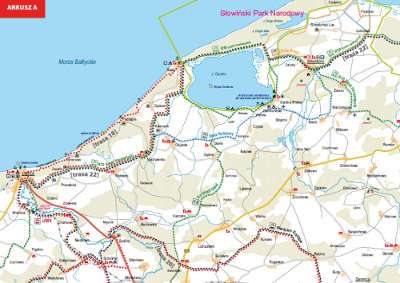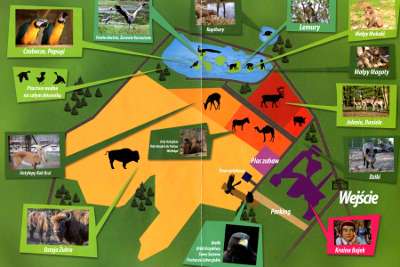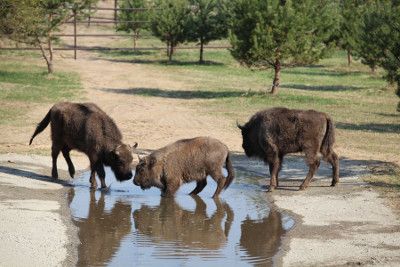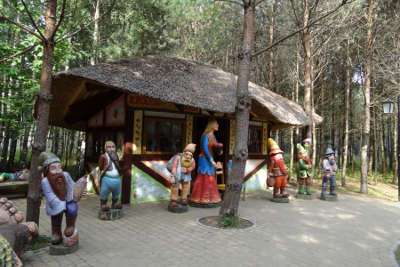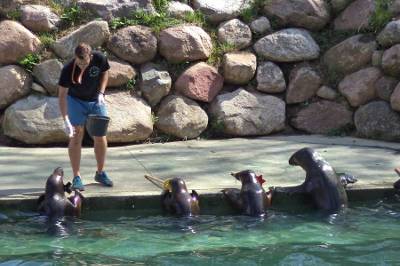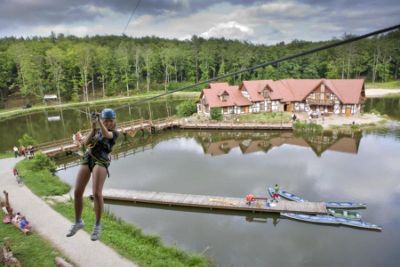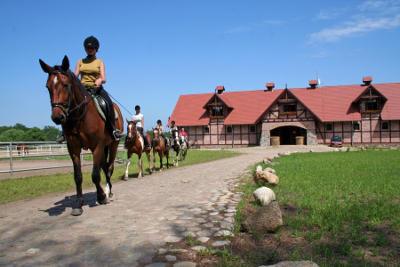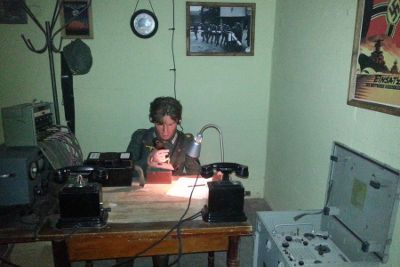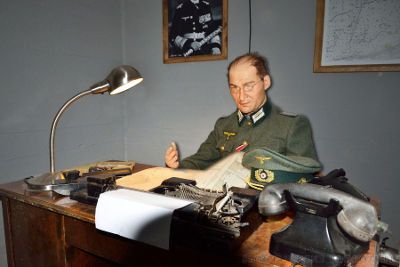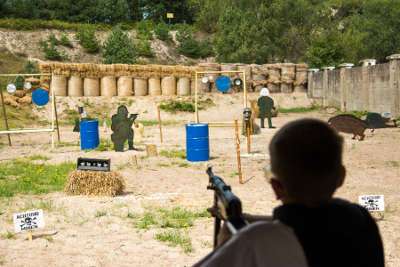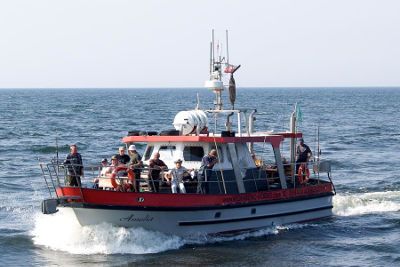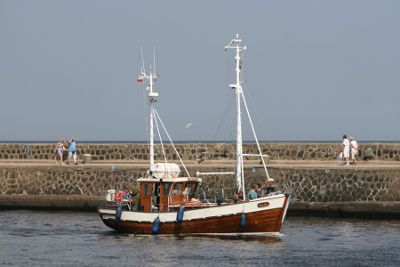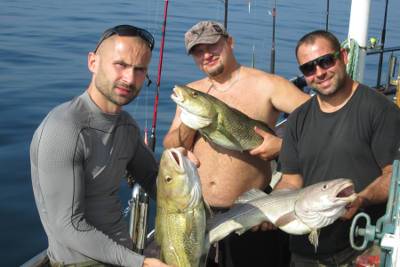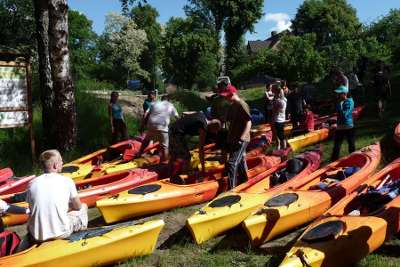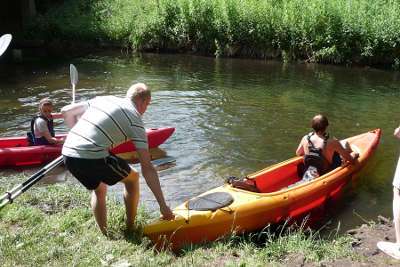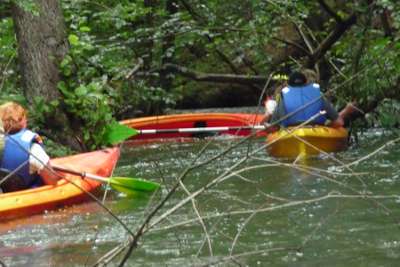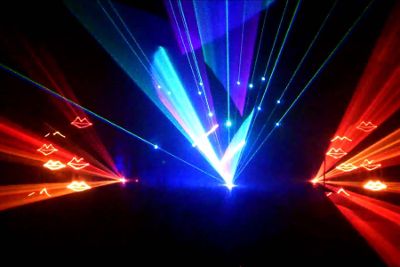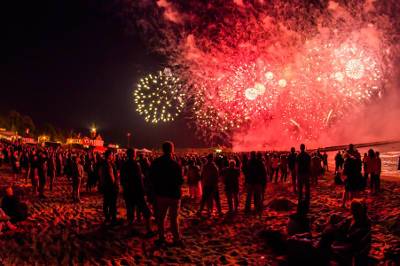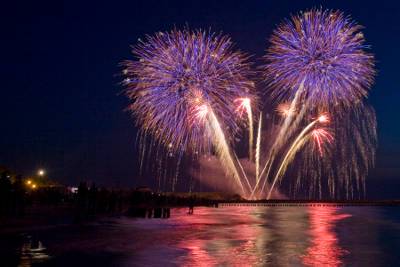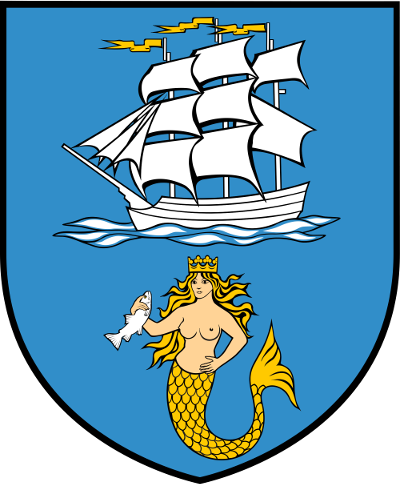
USTKA
THE TOWN
The first permanent settlers arrived at Ustka as early as the 9th century, and established a fishing settlement with the original name of Ujść. However, archeological findings indicate, that primitive fishermen had inhabited these lands since the stone age.
The first documented mention about Ustka comes from the 14th century. That's when the area at the mouth of the river Słupia (Stolpe) was ceded to the town of Słupsk (Stolp) in 1337 with the purpose of building a fishing harbour and a commercial port there to the Baltic Sea. Later on, the town was given to Brandenburg-Prussia as part of the Duchy of Pomerania after the Treaty of Westphalia in 1648. The current shape of the harbour is a result of an investment between 1899 and 1903 creating the largest port between Szczecin (Stettin) and Gdańsk (Danzig). As part of the Holy Roman Empire it was ruled by Dukes of Pomerania. After that, it became part of the Kingdom of Prussia, then the German Empire and Nazi Germany till 1945.
On August 1, 1945, the city became part of Poland with the agreement at the Potsdam Conference. After World War II, Ustka took steps to determine an official name. Ujść, Uszcz, and Ustka were all posted on the main railway station in 1945; Nowy Słupsk was the name on the sign at the main Post Office and Słupioujście was posted at the Harbour Master's office. The final name, Ustka, was decided upon in the late 1940s.
Nowdays, Ustka is a popular tourist destination and a fishing port on the south coasts of the Baltic. For a number of years, the town with two beautiful beaches divided by the river Słupia has won a string of local awards for the best summer place in the country. Since the end of the 19th century, Ustka has been recognised as a summer holiday resort and various illnesses treatment and recovery centre. Its population slightly extends 17 thousands of citizens and it hosts a couple hundreds of thousands tourists a year.
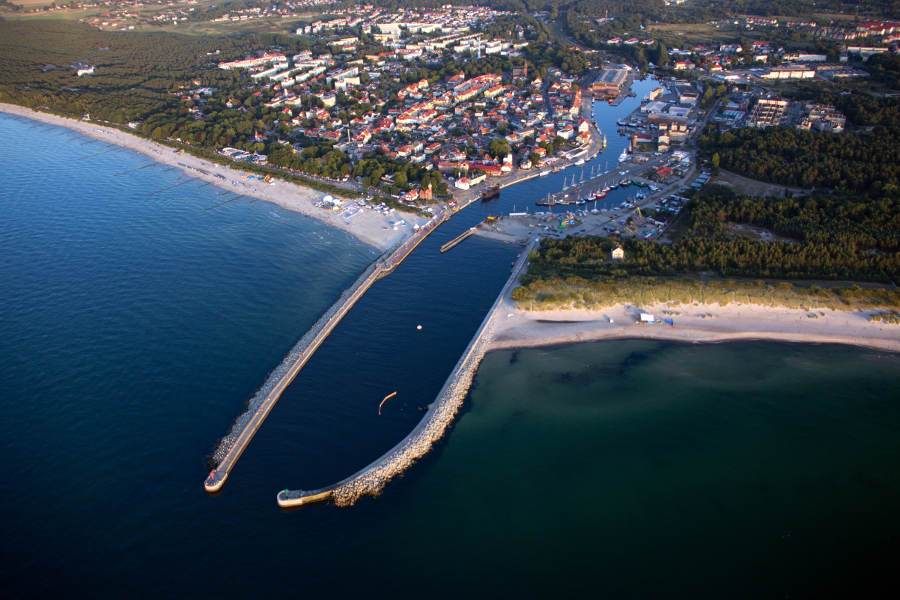
INTERESTING SITES IN USTKA
-
The historic lighthouse -
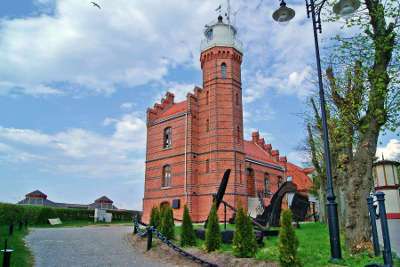 situated near the begining of the boardwalk, at the base of the harbour pier. In 1871, nearby the harbour's admiralty station, a mast with a an oil lamp was constructed. It shone with a red light and was visible at a distance of 6 nautical miles. In 1892 a new 2-store "pilots' station" was built. It was constructed of brick and had an octagonal tower ended with a "white lantern". The Ustka Lighthouse did not experience any damage during World War II and made it till now in its original shape. In 1993 it was oficially registered as a listed building. Nowdays, 2 bulbs (1000W power) and a Fresnel lens are the source of light for the lighthouse. In Ustka, they work in a 6-seconds cycle: 4 seconds glow and 2 seconds break. It is visible from the sea from a distance of 18 nautical miles. The tower of the lighthouse is 18,5m tall (60ft) and the source of light is on the height of 22,5m (70ft).
situated near the begining of the boardwalk, at the base of the harbour pier. In 1871, nearby the harbour's admiralty station, a mast with a an oil lamp was constructed. It shone with a red light and was visible at a distance of 6 nautical miles. In 1892 a new 2-store "pilots' station" was built. It was constructed of brick and had an octagonal tower ended with a "white lantern". The Ustka Lighthouse did not experience any damage during World War II and made it till now in its original shape. In 1993 it was oficially registered as a listed building. Nowdays, 2 bulbs (1000W power) and a Fresnel lens are the source of light for the lighthouse. In Ustka, they work in a 6-seconds cycle: 4 seconds glow and 2 seconds break. It is visible from the sea from a distance of 18 nautical miles. The tower of the lighthouse is 18,5m tall (60ft) and the source of light is on the height of 22,5m (70ft).
-
Ustka - the old town -
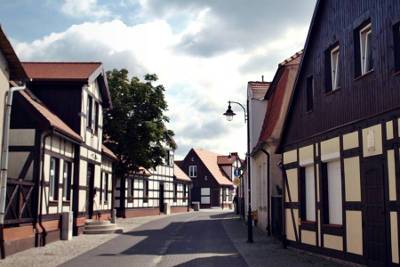 an aggregation of historical fishermen's cottages, the so called "checked-houses". In early medieval ages, Ustka was a Kashubian settlement strongly connected with the nearby Slupsk. Even nowdays, you can still feel the old vibrations in the area limited by "Marynarki Polskiej" and "Kosynierów" Streets. That's where you can still find the original constellation of roads of the medieval village. Since 2005, a restoration programme has been run in that part of rhe town. It aims at bringing the old fishermen checked-houses to their original look and restore a unique nature of the old town.
an aggregation of historical fishermen's cottages, the so called "checked-houses". In early medieval ages, Ustka was a Kashubian settlement strongly connected with the nearby Slupsk. Even nowdays, you can still feel the old vibrations in the area limited by "Marynarki Polskiej" and "Kosynierów" Streets. That's where you can still find the original constellation of roads of the medieval village. Since 2005, a restoration programme has been run in that part of rhe town. It aims at bringing the old fishermen checked-houses to their original look and restore a unique nature of the old town.
-
The harbour and the pier -
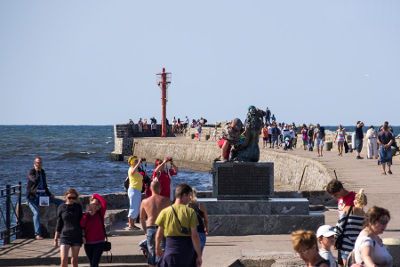 are the inseparable parts of Ustka's landscape strongly contributing to its marine complexion. Sizable stony breakwaters (the eastern and western mole) are not only parts of harbour infrastructure but also a comvinient destination for family walks with very attractive observation decks on the ends. The moles were raised to their present shape on the cusp of 19th and 20th century. Befor that, the entrance to the harbour was very narrow and the brakwaters were made of wooden chests filled with stones. The mood of the harbour those days was created by numerous taverns - there were 6 of them at the end of 18th century, which was plenty considering that Ustka counted only 50 citizens! An additional attraction is a foldaway catwalk, described in details below.
are the inseparable parts of Ustka's landscape strongly contributing to its marine complexion. Sizable stony breakwaters (the eastern and western mole) are not only parts of harbour infrastructure but also a comvinient destination for family walks with very attractive observation decks on the ends. The moles were raised to their present shape on the cusp of 19th and 20th century. Befor that, the entrance to the harbour was very narrow and the brakwaters were made of wooden chests filled with stones. The mood of the harbour those days was created by numerous taverns - there were 6 of them at the end of 18th century, which was plenty considering that Ustka counted only 50 citizens! An additional attraction is a foldaway catwalk, described in details below.
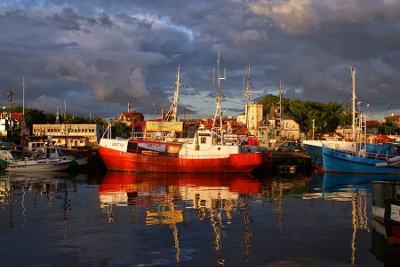 The harbour has been the heart of the settlement from the very medieval ages. The surrounding area has been succesively developed giving occupation and homes to an increasing number of citizens. The very harbour has been modernized and enlarged as well. The last huge project resulting in creation of a new harbourside basin for fishboats had just ended in 2015. Among the harbour buildings there are some worth mentioning due to their historical value. First is a house with 2 little towers which has been the customs house since the cusp of 19th and 20th century. The other one is a building made of red brick on Zaruskiego Street, which once was a harbour garner. It was used for storing of grain sent from Ustka on sailing ships to Scandinavia, England and Western Germany.
The harbour has been the heart of the settlement from the very medieval ages. The surrounding area has been succesively developed giving occupation and homes to an increasing number of citizens. The very harbour has been modernized and enlarged as well. The last huge project resulting in creation of a new harbourside basin for fishboats had just ended in 2015. Among the harbour buildings there are some worth mentioning due to their historical value. First is a house with 2 little towers which has been the customs house since the cusp of 19th and 20th century. The other one is a building made of red brick on Zaruskiego Street, which once was a harbour garner. It was used for storing of grain sent from Ustka on sailing ships to Scandinavia, England and Western Germany.
-
The seafront -
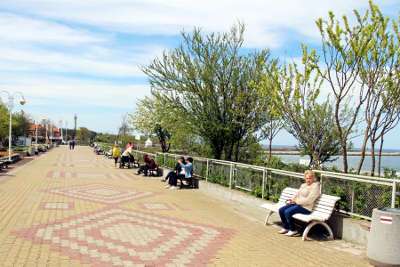 a piece of land adjacent to the beach is adopted for a broadwalk with lots of attractions, shoping booths, restaurants and entertainment. The seafront was built in 1875 - on the seaside dunes to the East from the harbour a hardened broadwalk was designed and dedicated strictly for recreational use. Those days, it was common that there were orchestra man standing and playing along the seafront. Those used to be invited from various towns - often very distant - for ecample from Czech. Soon, exclusive restaurants and pensions were built along the broadwałk. One of their famous clients posesing his own house in Ustka was Otto von Bismarck.
a piece of land adjacent to the beach is adopted for a broadwalk with lots of attractions, shoping booths, restaurants and entertainment. The seafront was built in 1875 - on the seaside dunes to the East from the harbour a hardened broadwalk was designed and dedicated strictly for recreational use. Those days, it was common that there were orchestra man standing and playing along the seafront. Those used to be invited from various towns - often very distant - for ecample from Czech. Soon, exclusive restaurants and pensions were built along the broadwałk. One of their famous clients posesing his own house in Ustka was Otto von Bismarck.
-
The Holy Saviour Church -
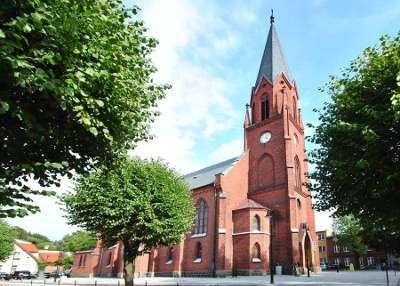 was constructed in the years 1885-1888 on a sandy dune outside of Ustka village, which was a reason for protests of its citizens. The contractor responsible for the construction was a local carpenter Franz Dreheim. One of the streets in Ustka was named after him (presently - Kopernika Street). A lot of elements were moved to a new church from the old one, situated by the harbour in the "Captain's Corner". The pipe organs in the church are one of the few made by the famous european manufacturer - the Voelkners and survived till now. If you are lucky, you can also listen to a local church choir, which was frequently appreciated and won multiple awards at sacral music festivals.
was constructed in the years 1885-1888 on a sandy dune outside of Ustka village, which was a reason for protests of its citizens. The contractor responsible for the construction was a local carpenter Franz Dreheim. One of the streets in Ustka was named after him (presently - Kopernika Street). A lot of elements were moved to a new church from the old one, situated by the harbour in the "Captain's Corner". The pipe organs in the church are one of the few made by the famous european manufacturer - the Voelkners and survived till now. If you are lucky, you can also listen to a local church choir, which was frequently appreciated and won multiple awards at sacral music festivals.
-
The faldaway catwalk -
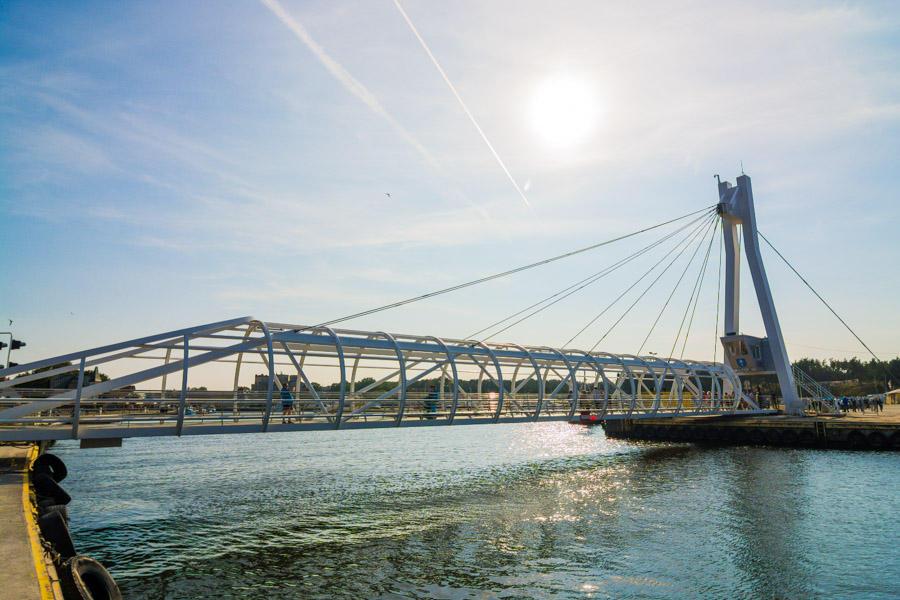 was constructed by Hydro-Naval - a local offshore and maritime industry company. It is the only bridge in Europe, which is folded away by a rotating mechanism located on a pylon.
was constructed by Hydro-Naval - a local offshore and maritime industry company. It is the only bridge in Europe, which is folded away by a rotating mechanism located on a pylon.
The catwalk was built to provide better communication between both sides of Ustka - the eastern and the western one. Before that, in order to cross the harbour channel, one needed to move deeply into the town - to the next bridge.
The total lenght of the catwalk is 57,78 meters and the width is 4 meters. The whole construction weights over 80 tons and can carry the load of 30 tons. The 24 meters tall pylon is on the western side of the harbour.
The catwalk opens and folds away in about 4 minutes. It can be operated unless the wind speed exceeds 10mps or the visibility drops below half a nautical mile. -
The museum of Ustka region -
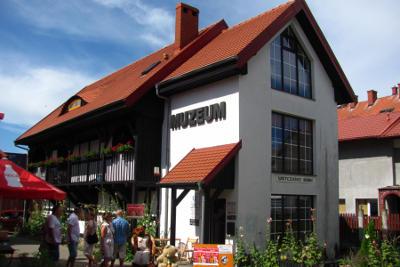 open since 2000, a collection of interesting exhibits associated with the town and the surrounding lands. In the museum, you will find old photographies from the cusp of 19th and 20th century, post-war document and keepsakes of the defunct Ustka Shipyard. Among the exhibits, you will find old cameras, typing machines, a hundred years old skate or a swimsuit from the begining of 20th century. The mementos of the shipyard are models of trawlers, cutters and laminate boats, historic medals, standards, photos and chronicles.
open since 2000, a collection of interesting exhibits associated with the town and the surrounding lands. In the museum, you will find old photographies from the cusp of 19th and 20th century, post-war document and keepsakes of the defunct Ustka Shipyard. Among the exhibits, you will find old cameras, typing machines, a hundred years old skate or a swimsuit from the begining of 20th century. The mementos of the shipyard are models of trawlers, cutters and laminate boats, historic medals, standards, photos and chronicles.
In the museum, there are also organized exhibitions of photos and paintings of local artists and hosted exhibitions from other regional cultural centers. Kids are welcome to join a lesson of history describing the life and habits of the early inahbitants of the town and the region. -
The siren of Ustka -
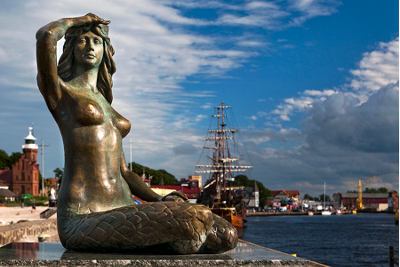 proudly occupies an honour spot on the Eastern mole in the place formerely intended for a high-power sound generator - "the tooter" - used for navigation during foggy days before the GPS era. Michał Ros is the author of the monument. The siren smiles and glances at visitors, who remain under her spell till the end of their lives.
An old wives tale says, that it brings luck to touch the siren's breasts. And that's why it is the most highly-polished part of her body. Or maybe that's just an excuse for gentelman willing to touch the inimitable beauty...
proudly occupies an honour spot on the Eastern mole in the place formerely intended for a high-power sound generator - "the tooter" - used for navigation during foggy days before the GPS era. Michał Ros is the author of the monument. The siren smiles and glances at visitors, who remain under her spell till the end of their lives.
An old wives tale says, that it brings luck to touch the siren's breasts. And that's why it is the most highly-polished part of her body. Or maybe that's just an excuse for gentelman willing to touch the inimitable beauty...
-
The Red Villa -
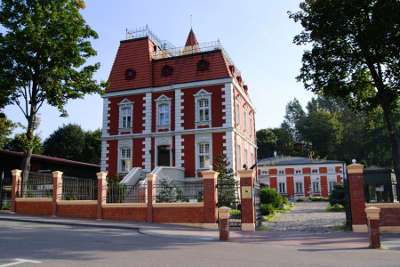 a summer residence built right by the Eastern beach in Ustka. Before Warld War II it was a property of the nazi, the marshall and the minister of aviation of of the German Reich, Hermann Göring. Though, the excentric owner was so busy with high priority cases, that he never actually happened to come to Ustka and stay at his exclusive mention.
a summer residence built right by the Eastern beach in Ustka. Before Warld War II it was a property of the nazi, the marshall and the minister of aviation of of the German Reich, Hermann Göring. Though, the excentric owner was so busy with high priority cases, that he never actually happened to come to Ustka and stay at his exclusive mention.
Nowdays, a neorenesans building is one of the prettiest and best-kept historical buildings in the town. It's architecture is characterized by simple but noble shapes. Pale, almost white corners enfold neat walls made of red brick - that's where the villa's name comes from. In the building there is a restaurant and a hotel and in summer time also a sea life aquarium. -
The dying warior -
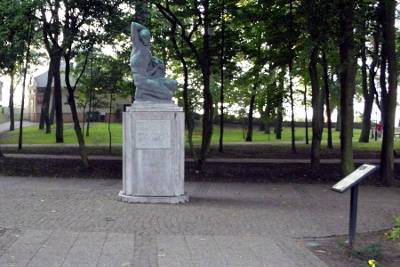 an interesting monument standing among lush park greenery, just about 40 yards away from "Fregata". The monument was founded in September 1922 to commemorate 76 citizens of Ustka, who died during the World War I. On the warrior's shield there is Ustka's coat of arms - showed for the first time. The monument was made by an austrian scalpturer Josef Thorak.
an interesting monument standing among lush park greenery, just about 40 yards away from "Fregata". The monument was founded in September 1922 to commemorate 76 citizens of Ustka, who died during the World War I. On the warrior's shield there is Ustka's coat of arms - showed for the first time. The monument was made by an austrian scalpturer Josef Thorak.
THE SEA, THE BEACH AND THE FOREST
The natural world around Ustka is surely the most attractive of its assets. Ustka lies in the middle of the polish baltic coast, away from large urban areas which makes it one of the cleanest places in Poland. There hasn't been a single time in the past, when beaches in Ustka needed to be closed due to water polution. Also the air, fresh and squeaky clean, makes you enjoy every single breath. The sea, the beaches and the surrounding forests are not only an endless source of aesthetic emotions but also an enormously large playground where, with a little assistance from adults, no child can get bored for a month...
-
The Baltic Sea -
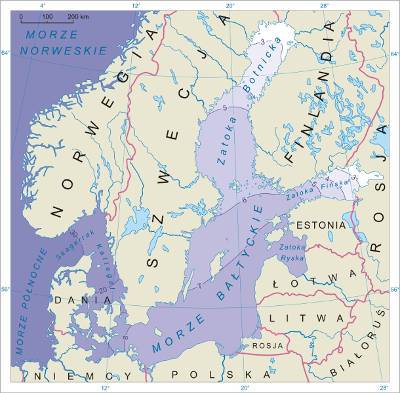 a shallow, 415 square kilometer body of water, counted among mediterranean seas, drains into the Atlantic Ocean through the danish islands. The avarage depth of the Baltic is 52,3 m, and the maximum depth - 459 m (The Landsort Depth to the North-West of Gotland).
a shallow, 415 square kilometer body of water, counted among mediterranean seas, drains into the Atlantic Ocean through the danish islands. The avarage depth of the Baltic is 52,3 m, and the maximum depth - 459 m (The Landsort Depth to the North-West of Gotland).
The salinity of Baltic varies from 2 to 12‰ (avarage 7‰) which clasifies it as a half-salty sea. That is due to relatively large amount of sweet water running into the sea from 250 rivers and low perspiration due to its low temperature.
The water level in the Baltic is slightly higher than in the Norh sea and the Atlantic Ocean, which is a consequence of accumulation of water in narrow danish straits. Tides are hardly observed on Baltic Sea - water level diffrences do not exceed 8cm per day.
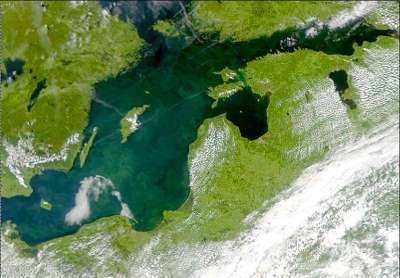 The Baltic is a rough sea. Waves are short and steep. Their typical height is 5m (16,5 ft). During stormy weather, waves are irregular, scattered and reach up to 10 m.
The Baltic is a rough sea. Waves are short and steep. Their typical height is 5m (16,5 ft). During stormy weather, waves are irregular, scattered and reach up to 10 m.
On December 23rd, 2004, during a severe storm on Northern Baltic, a record 14 m wave was observed (55 ft), which is just as tall as "Fregata" building together with the tower!
Surface water temperature varies from –0,5 to +20 degrees Celsius depending on the season. It is also dependend on the strides - water gets warmer when it blows from the West and colder when it blows from the East.
The name of our sea in most languages derives itself from the word "Baltic", however in german and scandinavian languages it is called "the Eastern Sea" and in Estonia "the Western Sea". -
The Baltic Coast -
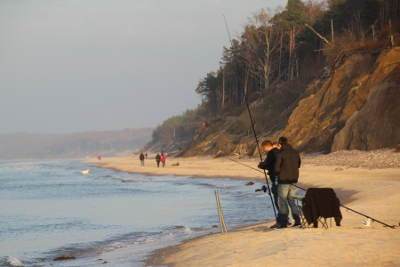 the most interesting part of marine scenery, also the most accessible for an average person. It is the scene of confrontation of the three remorseless elements: the water, the ground and the wind. They wage their primaval struggle leaving beautiful and majestatic monuments on the coastal battlefield. That's why we are lucky to admire steep and eerie cliffs just a few miles away from flat and broad sandy beaches.
the most interesting part of marine scenery, also the most accessible for an average person. It is the scene of confrontation of the three remorseless elements: the water, the ground and the wind. They wage their primaval struggle leaving beautiful and majestatic monuments on the coastal battlefield. That's why we are lucky to admire steep and eerie cliffs just a few miles away from flat and broad sandy beaches.
It is most likely to become a witness of coastal erosion in autumn and winter, when there are strong winds and severe storms claiming further pieces of land. Touristic localities protect the coast with more and more bracings and that's why our guests can enjoy sun-tanning on beautiful, broad beaches each year. However, if you go for a mile-long walk to the East from Ustka, you'll come across high and steep cliffs with fallen trees on the slope. -
Baltic beaches -
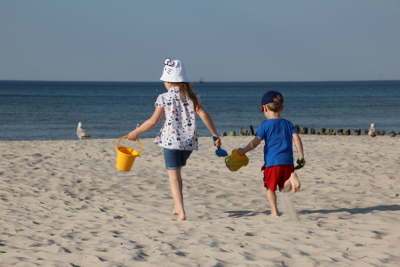 are counted among the most beatiful in the world. Anyone, who had a chance to lay their feet on rocky beaches of the Adriatic or walk on the coarse beach sand of the Mediterranean will appreciate the feeling of the baltic beach sand under their feet. The beaches, flat and clean sea bottom, and lack of dangerous sea-living make the Baltic coast a perfect destination for family vacation. This is where you can let the kids play for hours digging holes and raising sand castles without taking a hazard of expozing them to dangerous animals or plants. Every morning, the beach is cleaned by dedicated services in order for the tourists to fully enjoy the time spent by the sea.
are counted among the most beatiful in the world. Anyone, who had a chance to lay their feet on rocky beaches of the Adriatic or walk on the coarse beach sand of the Mediterranean will appreciate the feeling of the baltic beach sand under their feet. The beaches, flat and clean sea bottom, and lack of dangerous sea-living make the Baltic coast a perfect destination for family vacation. This is where you can let the kids play for hours digging holes and raising sand castles without taking a hazard of expozing them to dangerous animals or plants. Every morning, the beach is cleaned by dedicated services in order for the tourists to fully enjoy the time spent by the sea.
-
The artificial reef -
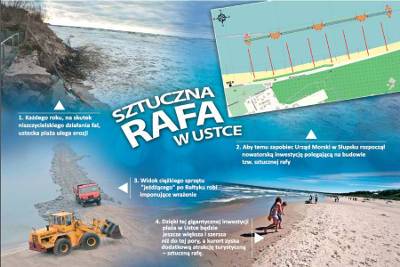 an innovative project realized in 2014 and 2015 aimed at building of underwater bars and habitats on the lenght of 1km (0.7 mile) along the beach, 200 meters (650 ft) away into the sea. 8 wooden carinas complement the construction creating a set of breakwaters transverse to the beach. The investment is intended to protect our beach and prevent coastal erosion. In effect, we expect to have a nice and broad beach, not subject to destructive influence of wind and water. And apart from the main issue, Ustka was given a new attraction - an interesting spot for diving and snorkeling adventures.
an innovative project realized in 2014 and 2015 aimed at building of underwater bars and habitats on the lenght of 1km (0.7 mile) along the beach, 200 meters (650 ft) away into the sea. 8 wooden carinas complement the construction creating a set of breakwaters transverse to the beach. The investment is intended to protect our beach and prevent coastal erosion. In effect, we expect to have a nice and broad beach, not subject to destructive influence of wind and water. And apart from the main issue, Ustka was given a new attraction - an interesting spot for diving and snorkeling adventures.
The reef begins exactly by the entrance to the beach nearest to "Fregata" and extends to the East. And so "Fregata" became an ideal base camp for both: exploring the reef and lazy san-bathing on the beach.
-
Amber - "the gold of the Baltic" -
fossilized sap of coniferous trees, which - within milions of years - has aquired a noble colour and hardness. Amber is higly regarded as a jewel thanks to its beauty but also due to a nice and warm touch.
Polish names for amber - "bursztyn" - derive itself from german "bernstein", which means "a stone that burns". Amber forms irregular nuggets varying in colour, size and shape. The biggest piece found on the Baltic coast weighted 9,75 kg (over 20 pounds).
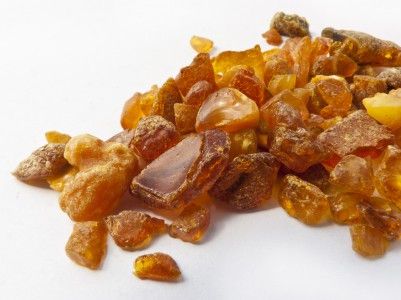 Yellow amber is most commonly found in nature. Rare variants are red, greenish or achromatic.
Yellow amber is most commonly found in nature. Rare variants are red, greenish or achromatic.
The transparency of amber depends on the concentration of small air bubbles in the stone. Some nuggets contain the so called inclusions - insects or plant parts trapped inside in the kenozoic era and stored unchanged for milions of years.
Baltic amber constitutes about 90% of total amber resources and is the most regarded by jewelers.
Amber is also known for its curative properties. In natural medicine, the amber joss stick smoke was used for its bectericidal properties and amber nuggets worn as necklesses prevented from sore throats and headaches. Heated amber nuggets were used to remove foreign bodies from ears and amber powder was snorted to cure rhinorrhea in common cold.
According to modern litotheraphy, amber tincture can be helpful in thyroid gland, throat and rheumatic disorders.
Large amounts of amber are exploited in amber mines, localized mainly in Kaliningrad Oblast. Smaller amounts can be found on beaches together with "amber rubbish" [exact translation of local idiomatic slang expression - a compound of small sticks, pieces of peat, sea grass and hopefully also amber nuggets] which is thrown on the sea shore by waves or taken out by ambermen with landing nets. [see the photos below]
-
Walking and bicycle paths -
situated in the surrounding forests and fields are fine places for family leisure. Some of them run through the top of the seaside cliffs providing unforgiven sights to the tourists.
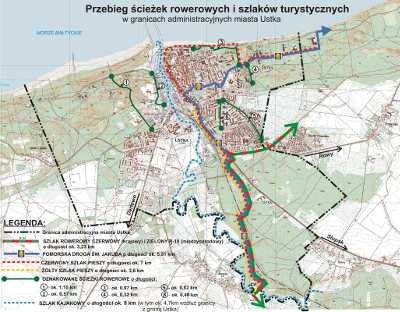 There are lots of prepared paths around Ustka designed for both, walking and cycling. Most popoular destinations for walking trips are Orzechowo (a small village near Ustka) and the so called "third pier" on the Western beach - both sites are about 3,5 km (2 miles) away from "Fregata".
There are lots of prepared paths around Ustka designed for both, walking and cycling. Most popoular destinations for walking trips are Orzechowo (a small village near Ustka) and the so called "third pier" on the Western beach - both sites are about 3,5 km (2 miles) away from "Fregata".
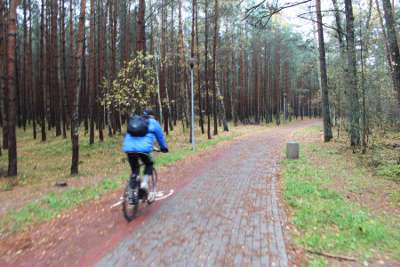 Most popular cycling paths are the so called "Rolled-up railway track" (about 18km = 11 miles one way) and st. Jakob's path from Ustka to Słupsk (about 21km = 13miles one way). You will find some of the walking and cycling paths on the map. You're welcome to contact the owners of "Fregata" for further information and advice.
Most popular cycling paths are the so called "Rolled-up railway track" (about 18km = 11 miles one way) and st. Jakob's path from Ustka to Słupsk (about 21km = 13miles one way). You will find some of the walking and cycling paths on the map. You're welcome to contact the owners of "Fregata" for further information and advice.
-
Nordic Walking -
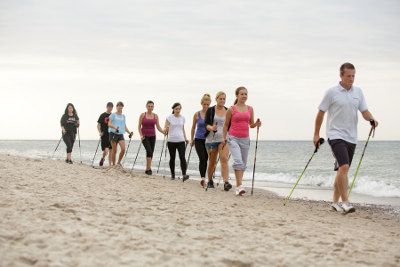 a total body version of walking that can be enjoyed both by non-athletes as a health-promoting physical activity, and by athletes as a sport. The activity is performed with specially designed walking poles similar to ski poles. It reliefs the spine and engages upper body, which makes it very beneficial for health and overall fitness.
Nordic walkers use more of their entire body (with greater intensity) and receive fitness building stimulation not present in normal walking for the chest, latissimus dorsi muscle, triceps, biceps, shoulder, abdominals, spinal and other core muscles that may result in significant increases in heart rate at a given pace. Nordic walking has been estimated as producing up to a 46% increase in energy consumption, compared to walking without poles, which is sought-after in slimming down theraphies. In "Fregata" you can borrow Nordic Walking poles for free, as well as get some basic hints from the owner who is a certified Nordic Walking instructor.
a total body version of walking that can be enjoyed both by non-athletes as a health-promoting physical activity, and by athletes as a sport. The activity is performed with specially designed walking poles similar to ski poles. It reliefs the spine and engages upper body, which makes it very beneficial for health and overall fitness.
Nordic walkers use more of their entire body (with greater intensity) and receive fitness building stimulation not present in normal walking for the chest, latissimus dorsi muscle, triceps, biceps, shoulder, abdominals, spinal and other core muscles that may result in significant increases in heart rate at a given pace. Nordic walking has been estimated as producing up to a 46% increase in energy consumption, compared to walking without poles, which is sought-after in slimming down theraphies. In "Fregata" you can borrow Nordic Walking poles for free, as well as get some basic hints from the owner who is a certified Nordic Walking instructor.
-
Orzechowo i wydma orzechowska -
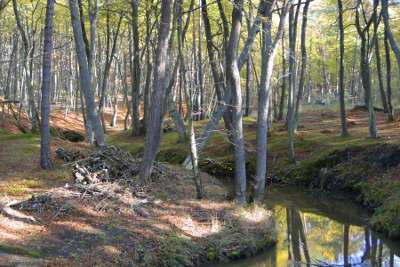 położone w enklawie leśnej przy ujściu do morza rzeczki Orzechówki. Urokliwa miejscowość jest oddalona od "Fregaty" o ok. 3,5km. Plaża orzechowska zakończona jest klifowym urwiskiem nieustannie kształtowanym przez morskie fale, pokrytym licznymi formami wydmowymi. Co roku w tym miejscu ubywa około 2,8 m wybrzeża pochłanianego przez morskie fale.
położone w enklawie leśnej przy ujściu do morza rzeczki Orzechówki. Urokliwa miejscowość jest oddalona od "Fregaty" o ok. 3,5km. Plaża orzechowska zakończona jest klifowym urwiskiem nieustannie kształtowanym przez morskie fale, pokrytym licznymi formami wydmowymi. Co roku w tym miejscu ubywa około 2,8 m wybrzeża pochłanianego przez morskie fale.
Nie jest to miejsce dla wielbicieli plażowania, bo brzeg jest tu wąski i kamienisty. Rekompensują to przepiękne lasy, ścieżki piesze i wysoki klif, które zachęcają aktywnych turystów do wycieczek. Dolina Orzechówki tworzy niezapomnianą scenerię, która jest inspiracją dla artystów fotografików i malarzy.
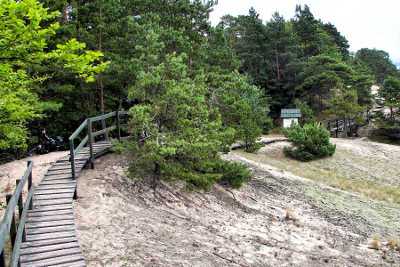 Ścieżka dydaktyczna "Orzechowska Wydma" położona jest w malowniczym terenie pomiędzy Orzechowem i sąsiednim Zapadłem. Jej przebieg w sąsiedztwie morskiego brzegu pozwala wyeksponować najbardziej charakterystyczne elementy nadmorskiego krajobrazu. Ścieżka ma długość 2,8 km i można ją pokonać w około 1 do 1,5 godziny. Trasa wiedzie poprzez paraboliczną, częściowo utrwaloną wydmę, której szczyt wyniesiony jest 23 metry ponad poziom sąsiedniej równiny przymorskiej. Wierzchowina moreny jest silnie pofałdowana i zajęta przez tzw. wydmę białą i szarą - te i wiele innych terminów objaśnia 11 tablic tematycznych, ustawionych przy ścieżce. Przejście ścieżką pozwala na zapoznanie się z wieloma unikatowymi stanowiskami roślinnymi, jakie wykształciły się na stosunkowo niewielkim obszarze wydmy.
Ścieżka dydaktyczna "Orzechowska Wydma" położona jest w malowniczym terenie pomiędzy Orzechowem i sąsiednim Zapadłem. Jej przebieg w sąsiedztwie morskiego brzegu pozwala wyeksponować najbardziej charakterystyczne elementy nadmorskiego krajobrazu. Ścieżka ma długość 2,8 km i można ją pokonać w około 1 do 1,5 godziny. Trasa wiedzie poprzez paraboliczną, częściowo utrwaloną wydmę, której szczyt wyniesiony jest 23 metry ponad poziom sąsiedniej równiny przymorskiej. Wierzchowina moreny jest silnie pofałdowana i zajęta przez tzw. wydmę białą i szarą - te i wiele innych terminów objaśnia 11 tablic tematycznych, ustawionych przy ścieżce. Przejście ścieżką pozwala na zapoznanie się z wieloma unikatowymi stanowiskami roślinnymi, jakie wykształciły się na stosunkowo niewielkim obszarze wydmy.
OTHER ATTRACTIONS
-
Dolina Charlotty -
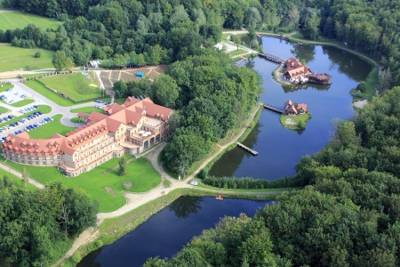 olbrzymi leśny kopleks rekreacyjny, położony w sąsiednim Gałęzinowie - ok 15km od "Fregaty". Można tam ciekawie spędzić co najmniej jeden cały dzień, nie skarżąc się na nudę. Do głównych atrakcji "Charlotty" należą:
olbrzymi leśny kopleks rekreacyjny, położony w sąsiednim Gałęzinowie - ok 15km od "Fregaty". Można tam ciekawie spędzić co najmniej jeden cały dzień, nie skarżąc się na nudę. Do głównych atrakcji "Charlotty" należą:
- ZOO wraz z krainą bajek i wodnym safari,
- ogromny park linowy z najdłuższym w Polsce zjazdem na linie,
- fokarium,
- jazda konna dla jeźdźców o różnym poziomie zaawansowania,
- jezioro z możliwością wypożyczenia sprzętu wodnego i połowu ryb.
Ponadto w resorcie można zjeść smaczny posiłek w restauracji na wodzie oraz wziąć udział w jednej z imprez okolicznościowych - koncercie muzycznym lub imprezie sportowej. Ponadto w resorcie można zjeść smaczny posiłek w restauracji na wodzie oraz wziąć udział w jednej z imprez okolicznościowych takich jak koncerty znanych zespołów muzycznych, czy współzawodnictwa sportowe.
[strona internetowa: www.dolinacharlotty.pl] -
Bunkry Baterii Blüchera -
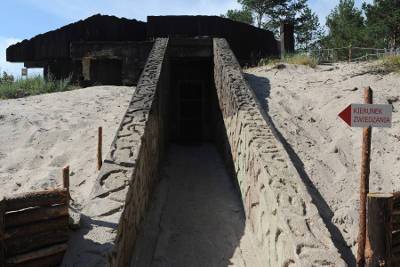 dawne poniemieckie stanowiska ogniowe, zagospodarowane w formie parku edukacyjno-rozrywkowego dla dorosłych i starszych dzieci. Bunkry znajdują się po zachodniej stronie miasta - najłatwiej jest dostać się do nich korzystając z kładki nad kanałem portowym (wówczas od "Fregaty" dzieli je ok. 1km) lub dojechać samochodem przez most zlokalizowany w głębi Ustki. Oprócz rekonstrukcji pomieszczeń wewnątrz fortyfikacji i pokazów multimedialnych, na terenie obiektu funkcjonuje kiermasz militarny, strzelnica ASG i strzelnica łuczcicza.
dawne poniemieckie stanowiska ogniowe, zagospodarowane w formie parku edukacyjno-rozrywkowego dla dorosłych i starszych dzieci. Bunkry znajdują się po zachodniej stronie miasta - najłatwiej jest dostać się do nich korzystając z kładki nad kanałem portowym (wówczas od "Fregaty" dzieli je ok. 1km) lub dojechać samochodem przez most zlokalizowany w głębi Ustki. Oprócz rekonstrukcji pomieszczeń wewnątrz fortyfikacji i pokazów multimedialnych, na terenie obiektu funkcjonuje kiermasz militarny, strzelnica ASG i strzelnica łuczcicza.
[strona internetowa: www.bunkryustka.pl] -
Rejsy wycieczkowe galeonami "Dragon" i "Unicus" -
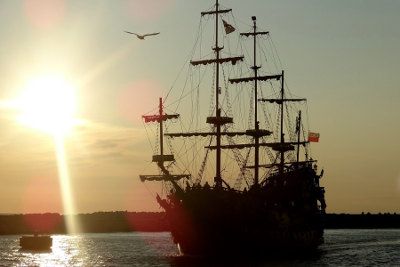 statki cumują w porcie Ustka (część wschodnia), naprzeciwko Kapitanatu Portu, obok Latarni Morskiej. Większy z galeonów - Dragon - wykonuje rejsy w miesiącach lipcu i sierpniu. Mniejszy - Unicus - pływa w Ustce od września do czerwca, a kiedy jego obowiązki latem przejmuje Dragon, wozi turystów w pobliskim Darłowie.
statki cumują w porcie Ustka (część wschodnia), naprzeciwko Kapitanatu Portu, obok Latarni Morskiej. Większy z galeonów - Dragon - wykonuje rejsy w miesiącach lipcu i sierpniu. Mniejszy - Unicus - pływa w Ustce od września do czerwca, a kiedy jego obowiązki latem przejmuje Dragon, wozi turystów w pobliskim Darłowie.
[strona internetowa: galeony.pl]
- Morskie rejsy wędkarskie - organizowane przez licznych armatorów niewielkich jednostek pływających, cumujących przy usteckim nabrzeżu. Jest to prawdziwa gratka dla miłośników wędkarstwa, którzy na takich wyprawach mogą złowić swoje życiowe okazy!
-
Spływy kajakowe Słupią -
jednodniowe (4-7 - godzinne) lub weekendowe spływy kajakowe pięknymi odcinkami Słupii ale też rzek takich jak Łupawa czy Bukowina. Firma zapewnia transport kajaków i kierowców spływu oraz dysponuje miejscem parkingowym.
[strona internetowa: www.slupia-kajaki.pl] -
Wypożyczalnie gokartów -
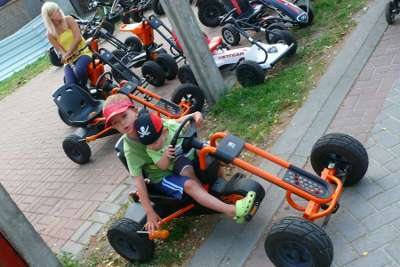 dysponują 3 lub 4-kołowymi pojazdami, którymi może jechać od 1 do 6 osób. Przejażdźka gokartem może być ciekawym sposobem na rodzinne zwiedzanie miasta lub po prostu atrakcją dla małych rajdowców, którzy z zaciśniętymi zębami wchodzą w ostre zakręty na alejkach okolicznych parków. W bezpośredniej bliskości "Fregaty" w sezonie letnim funkcjonuje kilka takich wypożyczalni.
dysponują 3 lub 4-kołowymi pojazdami, którymi może jechać od 1 do 6 osób. Przejażdźka gokartem może być ciekawym sposobem na rodzinne zwiedzanie miasta lub po prostu atrakcją dla małych rajdowców, którzy z zaciśniętymi zębami wchodzą w ostre zakręty na alejkach okolicznych parków. W bezpośredniej bliskości "Fregaty" w sezonie letnim funkcjonuje kilka takich wypożyczalni.
Na terenie Miejskiego Ośrodka Sportu i Rekreacji, każdego lata funkcjonuje też tor kartingowy dla dorosłych i dzieci z prawdziwymi gokartami, napędzanymi silnikiem.
-
Lech Fire Festival -
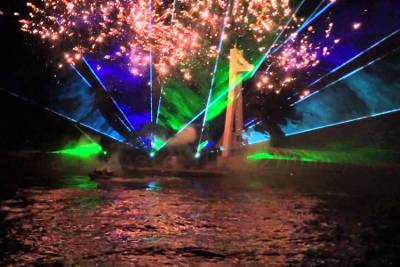 najbardziej wystrzałowa tego typu impreza w Polsce. Magiczne spektakle światła i dźwięku co rok przyciągają wielotysięczną publiczność. Nic dziwnego, skoro
można zobaczyć tam najbardziej doświadczonych specjalistów od widowisk pirotechnicznych rywalizujących o względy coraz bardziej wymagających widzów. Pokazy fajerwerków zaczynają się zwykle ok. godz. 23:00 i są poprzedzone koncertami znanych zespołów muzycznych, a od 2014 roku także pokazami laserów.
najbardziej wystrzałowa tego typu impreza w Polsce. Magiczne spektakle światła i dźwięku co rok przyciągają wielotysięczną publiczność. Nic dziwnego, skoro
można zobaczyć tam najbardziej doświadczonych specjalistów od widowisk pirotechnicznych rywalizujących o względy coraz bardziej wymagających widzów. Pokazy fajerwerków zaczynają się zwykle ok. godz. 23:00 i są poprzedzone koncertami znanych zespołów muzycznych, a od 2014 roku także pokazami laserów.
Wiele ludzi spędza długie godziny w korkach przed Ustką aby móc zobaczyć imponujące widowisko. Goście "Fregaty" nie muszą martwić się o dojazd, bo po zakończonej imprezie od ciepłego łóżka dzieli ich zaledwie 10-minutowy spacer.



